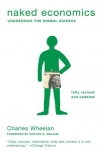Naked Economics Wheelan, Charles (books to read for 13 year olds TXT) 📖

Book online «Naked Economics Wheelan, Charles (books to read for 13 year olds TXT) 📖». Author Wheelan, Charles
* Your actual return would be much higher, since much of the purchase would be financed. If you put $50,000 down, for example, you would have earned $250,000 on a $50,000 investment (minus the interest you paid to carry the mortgage during the period you owned the house).
* The expected return is 0.5($400,000) + 0.5($0) = $200,000, which is a 100 percent return on your $100,000 investment.
† This exercise is somewhat oversimplified. The flips of a coin are independent, while the performance of individual stocks are not. Some events, such as an interest rate hike, will affect the whole market. Thus, buying two stocks will not offer as much diversification as would splitting your portfolio between two flips of a coin. Nonetheless, the broader point is valid.
* To derive the Gini index, the personal incomes in a country are arranged in ascending order. A line, the Lorenz curve, plots the cumulative share of personal income against the cumulative share of population. Total equality would be a 45-degree line. The Gini coefficient is the ratio of the area between the diagonal and the Lorenz curve to the total area under the diagonal.
* I can’t remember the exact numbers, but they were something along these lines.
* Okay, that’s not exactly true. At the height of the financial crisis, right around the time that Lehman Brothers declared bankruptcy, the yield on three-month U.S. Treasury notes fell below zero, which means that the nominal interest rate had turned negative. Remarkably, investors were paying more for something than it promised to pay them back in three months. For policymakers, this was a sign of panic. Keith Hennessey, director of the National Economic Council in the White House, told James Stewart of The New Yorker, “Treasury rates went negative! People were locking in a loss just to protect their money.”
* Soros borrowed a huge sum in British pounds and immediately traded them for stronger currencies, such as the German deutsche mark. When the Brits eventually dropped out of the ERM and devalued the pound, he swapped his currency holdings back for more pounds than he had originally borrowed. He paid back his loans and kept the difference. Numbers make this all more intuitive. Suppose Soros borrowed 10 billion pounds and swapped them immediately for 10 billion deutsche marks. (The exchange rates and amounts are contrived to make the numbers easier.) When the pound was devalued, its value fell by more than 10 percent, so that 10 billion deutsche marks subsequently bought 11 billion pounds. Soros swapped his 10 billion deutsche marks for 11 billion pounds. He paid back his 10-billion-pound loan and kept the tidy balance for himself (or, more accurately, for his investment funds). Soros supplemented his currency gains with ancillary bets related to how the devaluation would affect European stocks and bonds.
* Economists make a distinction between the nominal exchange rate, which is the official rate at which one currency can be exchanged for another (the numbers posted on the board at the currency exchange), and the real exchange rate, which takes inflation into account in both countries and is therefore a better indicator of changes in purchasing power of one currency relative to another. For example, assume that the U.S. dollar can be exchanged at your local bank for 10 pesos. Further assume that (1) inflation is zero in the United States and 10 percent annually in Mexico; and (2) a year later your local bank will exchange $1 for 11 pesos. In nominal terms, the U.S. dollar has appreciated 10 percent relative to the peso (each dollar buys 10 percent more pesos). But the real exchange rate hasn’t changed at all. You will get 10 percent more pesos at the currency exchange window than you did last year, but because of inflation over the course of the year, each peso now buys 10 percent less than it used to. As a result, the total purchasing power of the pesos that you get from the bank teller this year for your $100 is exactly the same as the purchasing power of the (fewer) pesos you got for your $100 last year. Any reference to exchange rates in the balance of this chapter refers to real exchange rates.





Comments (0)